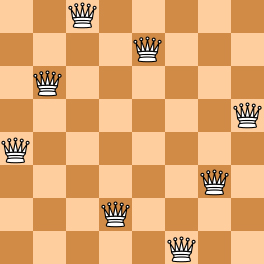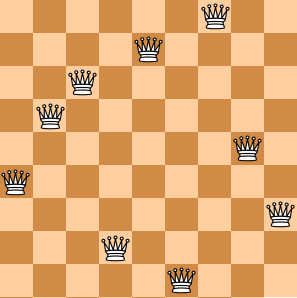The "eight queens puzzle" is the problem of placing eight chess queens on an 8×8 chessboard so that no two queens threaten each other. Thus, a solution requires that no two queens share the same row, column, or diagonal. The eight queens puzzle is an example of the more general N queens problem of placing N non-attacking queens on an N×N chessboard. (From Wikipedia - "Eight queens puzzle".)
Here you are NOT asked to solve the puzzles. Instead, you are supposed to judge whether or not a given configuration of the chessboard is a solution. To simplify the representation of a chessboard, let us assume that no two queens will be placed in the same column. Then a configuration can be represented by a simple integer sequence (Q1,Q2,⋯,QN), where Qi is the row number of the queen in the i-th column. For example, Figure 1 can be represented by (4, 6, 8, 2, 7, 1, 3, 5) and it is indeed a solution to the 8 queens puzzle; while Figure 2 can be represented by (4, 6, 7, 2, 8, 1, 9, 5, 3) and is NOT a 9 queens' solution.
|
|
| |
|---|---|---|
| Figure 1 | Figure 2 |
Input Specification:
Each input file contains several test cases. The first line gives an integer K (1<K≤200). Then K lines follow, each gives a configuration in the format "N Q1 Q2 ... QN", where 4≤N≤1000 and it is guaranteed that 1≤Qi≤N for all i=1,⋯,N. The numbers are separated by spaces.
Output Specification:
For each configuration, if it is a solution to the N queens problem, print YES in a line; or NO if not.
Sample Input:
4
8 4 6 8 2 7 1 3 5
9 4 6 7 2 8 1 9 5 3
6 1 5 2 6 4 3
5 1 3 5 2 4
Sample Output:
YES
NO
NO
YES
Code:
#include<bits/stdc++.h>
using namespace std;
const int N=1100;
int n;
bool row[N],udg[N*2],dg[N*2];
int main(){
cin>>n;
while(n--){
memset(row,0,sizeof row);
memset(udg,0,sizeof udg);
memset(dg,0,sizeof dg);
int k;
cin>>k;
// cout<<k<<endl;
bool flag=true;
for(int i=1;i<=k;i++){
int x;
cin>>x;
if(!udg[i-x+k]&&!dg[x+i]&&!row[x]){
udg[i-x+k]=true;
dg[x+i]=true;
row[x]=true;
}else{
flag=false;
}
}
if(flag)
puts("YES");
else
puts("NO");
}
}







 本文介绍了一个编程题目,要求判断给定的棋盘配置是否满足N皇后问题的条件,即不使任何两个皇后互相威胁。程序通过检查行、列和对角线来确定答案。
本文介绍了一个编程题目,要求判断给定的棋盘配置是否满足N皇后问题的条件,即不使任何两个皇后互相威胁。程序通过检查行、列和对角线来确定答案。


















 1180
1180

 被折叠的 条评论
为什么被折叠?
被折叠的 条评论
为什么被折叠?








